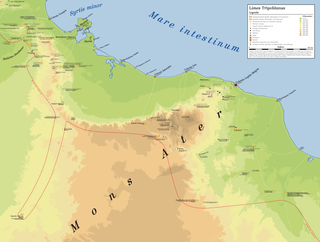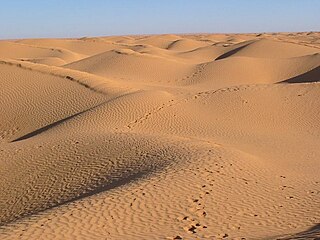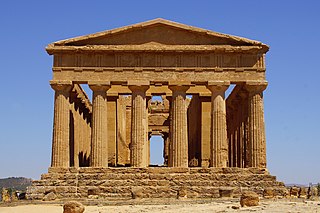
Fezzan is the southwestern region of modern Libya. It is largely desert, but broken by mountains, uplands, and dry river valleys (wadis) in the north, where oases enable ancient towns and villages to survive deep in the otherwise inhospitable Sahara Desert. The term originally applied to the land beyond the coastal strip of Africa proconsularis, including the Nafusa and extending west of modern Libya over Ouargla and Illizi. As these Berber areas came to be associated with the regions of Tripoli, Cirta or Algiers, the name was increasingly applied to the arid areas south of Tripolitania.

Ancient Roman temples were among the most important buildings in Roman culture, and some of the richest buildings in Roman architecture, though only a few survive in any sort of complete state. Today they remain "the most obvious symbol of Roman architecture". Their construction and maintenance was a major part of ancient Roman religion, and all towns of any importance had at least one main temple, as well as smaller shrines. The main room (cella) housed the cult image of the deity to whom the temple was dedicated, and often a table for supplementary offerings or libations and a small altar for incense. Behind the cella was a room or rooms used by temple attendants for storage of equipment and offerings. The ordinary worshiper rarely entered the cella, and most public ceremonies were performed outside where the sacrificial altar was located, on the portico, with a crowd gathered in the temple precinct.

Paestum was a major ancient Greek city on the coast of the Tyrrhenian Sea in Magna Graecia. The ruins of Paestum are famous for their three ancient Greek temples in the Doric order, dating from about 550 to 450 BC, which are in an excellent state of preservation. The city walls and amphitheatre are largely intact, and the bottom of the walls of many other structures remain, as well as paved roads. The site is open to the public, and there is a modern national museum within it, which also contains the finds from the associated Greek site of Foce del Sele.

Sabratha, in the Zawiya District of Libya, was the westernmost of the ancient "three cities" of Roman Tripolis, alongside Oea and Leptis Magna. From 2001 to 2007 it was the capital of the former Sabratha wa Sorman District. It lies on the Mediterranean coast about 70 km (43 mi) west of modern Tripoli. The extant archaeological site was inscribed as a UNESCO World Heritage Site in 1982.

Ghadames or Ghadamis is an oasis Berber town in the Nalut District of the Tripolitania region in northwestern Libya.

Lagina or Laginia (Λαγινία) was a town in the territory of Stratonicea, in ancient Caria. It contained an important temple of Hecate, at which every year great festivals were celebrated. Tacitus, when speaking of the worship of Trivia among the Stratoniceans, evidently means Hecate. Its site is located near Turgut, Asiatic Turkey.

Apollonia in Cyrenaica was founded by Greek colonists and became a significant commercial centre in the southern Mediterranean. It served as the harbour of Cyrene, 20 km (12 mi) to the southwest.

The Limes Tripolitanus was a frontier zone of defence of the Roman Empire, built in the south of what is now Tunisia and the northwest of Libya. It was primarily intended as a protection for the tripolitanian cities of Leptis Magna, Sabratha and Oea in Roman Libya.

The Temple of Hadrian is an ancient Roman structure on the Campus Martius in Rome, Italy, dedicated to the deified emperor Hadrian by his adoptive son and successor Antoninus Pius in 145 CE This temple was previously known as the Basilica of Neptune but has since been properly attributed as the Temple of Hadrian completed under Antoninus Pius. With one cella wall and eleven columns from the external colonnade surviving, the remains of the temple have been incorporated into a later building in the Piazza di Pietra, whereby its facade, alongside the architrave which was reconstructed later on, was incorporated into a 17th-century papal palace by Carlo Fontana, now occupied by Rome's Chamber of commerce. While only part of the structure remains, excavations and scholarship have provided us with information regarding its construction techniques and stylistic influences, helping us recreate the building dynamics and significance of the Temple of Hadrian in Imperial Rome.

The Temple of Claudius or Temple of the Deified Claudius was a large octastyle temple built in Camulodunum, the modern Colchester in Essex. The main building was constructed between 49 and 60 AD, although additions were built throughout the Roman-era. Today it forms the base of the Norman Colchester Castle. It is one of at least eight Roman-era pagan temples in Colchester, and was the largest temple of its kind in Roman Britain; its current remains potentially represent the earliest existing Roman stonework in the country.

David John Mattingly, FBA is an archaeologist and historian of the Roman world. He is currently Professor of Roman Archaeology at the University of Leicester.

The Grand Erg Oriental is a large erg or "field of sand dunes" in the Sahara Desert. Situated for the most part in Saharan lowlands of northeast Algeria, the Grand Erg Oriental covers an area some 600 km wide by 200 km north to south. The erg's northeastern edge spills over into neighbouring Tunisia.

Tourism in Libya is an industry heavily hit by the Libyan Civil War. Before the war tourism was developing, with 149,000 tourists visiting Libya in 2004, rising to 180,000 in 2007, although this still only contributed less than 1% of the country's GDP. There were 1,000,000 day visitors in the same year. The country is best known for its ancient Greek and Roman ruins and Sahara desert landscapes.

The Valle dei Templi, or Valley of the Temples, is an archaeological site in Agrigento, Sicily. It is one of the most outstanding examples of ancient Greek art and architecture, and is one of the main attractions of Sicily.

The Germa Museum is an archaeological museum located in Fezzan, Libya. It contains old objects excavated at Germa, the seat of the ancient Garamantian Kingdom. The Garamantian Kingdom flourished between 400 BC and 600 AD.
Saraain El Faouqa is a village located 6 kilometres (3.7 mi) northeast of Rayak in Baalbek District, Baalbek-Hermel Governorate, Lebanon. Most of its inhabitants Shia Muslims and a minority are Maronites.

Gasr Banat or Gasr Isawi is an archaeological site near Bani Walid in Libya and the location of an Ancient Roman centenarium or "perched" oppidum. The area is also used as a semi-permanent camp for nomads. It was studied by Graeme Barker in 1984. Evidence from pottery found around the site suggests the date of construction was in the third century CE.
Shhiim alternatively written as Shheem or Chhim/Shleem is a town in Lebanon which is located 40 kilometres south-east of Beirut. Shhiim is located on 4 mountains in the Chouf region in lebanon. Chhim has a population of about 49,000. It is considered a city by some.

Atiq Mosque is located in Ghadames, Libya. Originally constructed in 1258, it is one of the main and largest mosque of the old town of Ghadames.


















